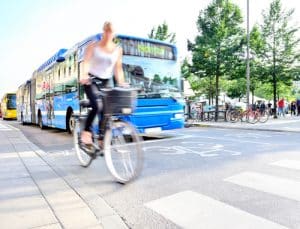You Are Invisible
 I’d estimate that in more than 90% of the cycling case I’ve handled, the vehicle drivers say they just didn’t see the cyclists. So here’s the most important rule to remember when you ride your bike, especially if you are alone: YOU ARE INVISIBLE.
I’d estimate that in more than 90% of the cycling case I’ve handled, the vehicle drivers say they just didn’t see the cyclists. So here’s the most important rule to remember when you ride your bike, especially if you are alone: YOU ARE INVISIBLE.
In the Texas Driver’s Handbook it says “in every situation, right-of-way is something to be given, not taken.” And as a cyclist, you just can’t take something that is not being given. Yes, legally you are right and you had the right-of-way, but when you start arguing about rights, the damage has been done. Yes, you have the right of way, but it’s far better to not have to argue about rights.
Some ideas to consider:
- Ride in a Group: A car driver might not see a lone cyclist or two, but will see a large group. (I have handled only one case where a rider was hit in a group. The rest have all been solo riders or with one other person.)
- Intersections: Danger-Danger: There are a few different scenarios to consider.
- Side Traffic has Stop Sign: At an intersection where you have the right-of-way and the other driver has a stop sign, notice how fast the other driver approaches the stop sign. If they are moving pretty fast (like they are going to make a “California Stop”), then you must assume that they don’t see you. They are in a hurry. They are looking for a car. They aren’t looking for a cyclist. You are invisible. Get ready to stop.
- Intersection Controlled by a Traffic Signal: If there are two lanes going both ways, and you are a car or two back when the light changes, you really would be invisible to the oncoming traffic. You simply must assume that at a busy intersection, there are cars that will be turning into you.
- Trails-Sidewalk Crossings: If you are riding on a trail or a sidewalk that crosses a driveway or road, a driver simply does not anticipate seeing a bicycle that is moving much faster than a pedestrian. As such, you are invisible to the car driver. If you are crossing a cross-walk, anticipate a car making a right turn on red when you are crossing. If you are on the sidewalk and crossing a driveway, anticipate the danger that any car in the area might pose.
- Eye Contact: Just because you look into the face of the driver don’t assume that the driver sees you. They don’t. If they wave you on or through, they see you. Otherwise, you must assume that they do not.
- Sun in Eyes: If you are riding towards the sun, then you are in serious danger.
- Rear View Mirror: There are low profile, small mirrors that attach directly to the helmet – using one can tell you if the driver behind you actually sees you before he passes.
- Lights: Wear a tail light even during the day. And if you ride when it is dark/dawn/dusk, get a headlight, and don’t get a cheap one. Get the most lumens you can. You do want to be seen.
